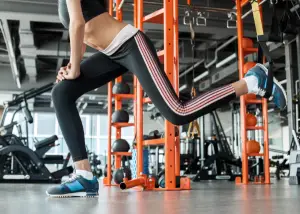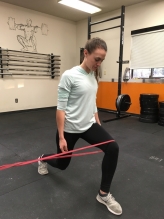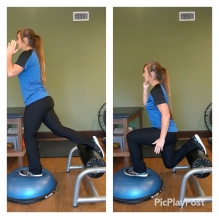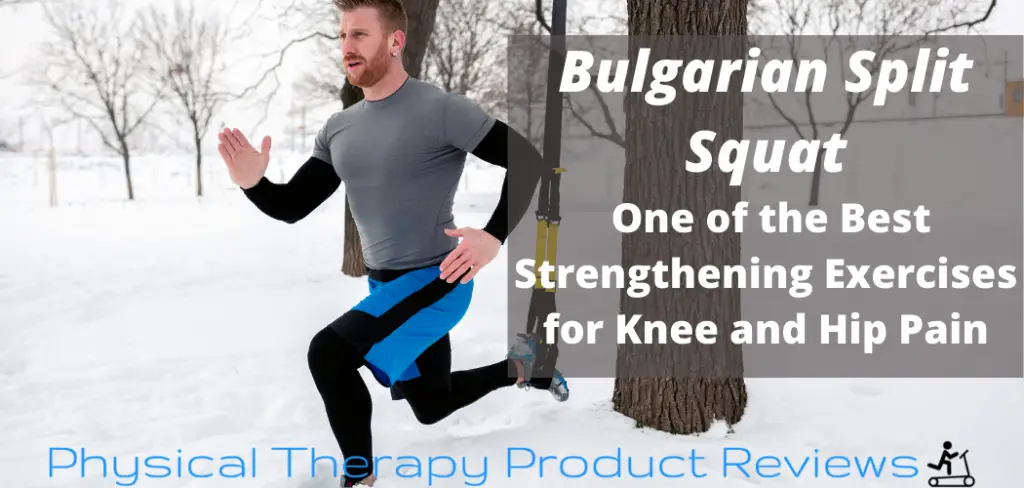The Bulgarian Split Squat is a great strengthening exercise for knee and/or hip pain. It’s inexpensive to do, targets hip and knee strength, works on balance, is easy on the back and other joints, is simple to progress as your body gets stronger and helps with alignment control. This is truly an exercise that hits just about everything at once.
If you’re looking for a way to strengthen your knees that don’t involve weight lifting or an expensive machine, this article is for you. We’ll review why we love the Bulgarian Split squat, who should be doing this exercise, when to avoid it, and how to do it properly.

What is the Bulgarian Split Squat
The Bulgarian Split squat is almost a mix between a lunge and a single-leg squat. It’s one of our favorite exercises that strengthens the entire leg and incorporates the core and back muscles. It’s a dynamic movement lowering yourself down to the floor on one leg while controlling the rotation and balance of the body.

The Split Squat has high muscle activation of the quads, glutes, hamstrings, and calf muscles. It’s a particularly great exercise to work on the stability of the hip joint and work on motor control and alignment of the leg.
Who Should be Doing the Split Squat Exercise
This is a great exercise to strengthen the legs in the gym, but it’s also fantastic for people with knee and hip pain. The Split squat works on strengthening all of the muscles in the leg while also improving balance and core strength at the same time. Its low impact makes it perfect if you have any knee injuries or are looking to rehab after an injury.
The people that get the most benefit from the Split squat are:
- Anyone rehabbing a knee, hip, or ankle injury
- Someone looking to improve balance
- Anyone with patellofemoral pain syndrome
- Anyone with a hip labral tear
- Anyone looking to improve performance in sports
- Anyone looking to return to or get back into shape for skiing, waterskiing, and biking
Who Should Avoid a Rear Foot Elevated Split Squat
A couple of groups of people should avoid the Bulgarian Split Squat. As with any exercise, if you are unsure if you are healthy enough ask your physical therapist or medical doctor before attempting.
If you have recently had surgery, it’s best to consult your Physical Therapist first before doing this or any other exercise for lower body strengthening. You can also try some balance exercises on an unstable surface like a foam pad instead of performing the Bulgarian Split Squat.
If you have severe balance issues, it’s best to avoid the Bulgarian Split squat since it requires a lot of control and coordination to do it safely. If you have had a recent fall or a history of falls, there are better alternatives to look for.
Finally, anyone who is not healthy enough for exercise should look for an alternative exercise. This is an advanced exercise, so it’s best to start with easier exercise until you are healthy enough to perform advanced exercises. If this is the case, start with some simple balance exercises instead and work on strength in one leg at a time before progressing to split squats.
How to Do the Bulgarian Leg Elevated Split Squat
To perform this exercise, stand in front of a chair, bench, or some other surface that’s about knee height. Take a large step forward in front of the bench with one foot and place the top of your other, rearfoot, on the bench with just a little pressure to help balance.
You can hold onto something sturdy in front of you for balance if needed.
Slowly lower yourself down by bending at both knees until your rear knee almost touches the ground, then push back up again using only the front leg while keeping your core tight.
Make sure to keep your chest up straight and your leg in a straight line from your hip to your knee to your toe, and don’t let it move in or out sideways.

What Muscles Does the Bulgarian Split Squat Work?
The Bulgarian Split Squat works the entire leg while also working on core strength to maintain proper form. It’s easy on the joints in the back and knee when done properly, but it targets muscles that are typically weak in people with knee pain like:
- Quadriceps (front thigh muscle)
- Gluteus Maximus (butt muscle)
- Hip Abductors (Gluteus Medius and Gluteus Mininus)
- Hamstrings (back of thigh muscle)
- Gastrocnemius and Soleus (calf muscles)
- Core Muscles: Rectus Abdominus, Obliques abdominals, Erector Spinae
How to Modify Bulgarian Split Squats for People Who are Not Ready
If this exercise is too much for you or you are still recovering from an injury, there are ways to modify the difficulty. Try these tips and make sure you don’t try and push through sharp pain. Instead, work on strength and balance until you can progress without pain:
- Do the split squat against a wall to use your hands for support
- Don’t put your back foot on an elevated surface but instead leave it on the ground
- Don’t go as deep down to the floor, stop when you feel discomfort
- Hold on to a table or chair with both hands for balance
- Stagger Your feet so they aren’t in a straight line for less balance difficulty
If you really can’t do this yet, try out some single-leg balance exercises instead. Some other great alternatives are a single leg balance, lunges, or an eccentric lateral step-down exercise (another favorite of ours).
How To Make the Bulgarian Split Squat More Challenging
When you have mastered the Bulgarian Split squat as it is, there are a few ways to make it more challenging. The most common ways to make an exercise more difficult include increasing resistance, adding an element of instability, or increase amount of tasks performed during the exercise. Some examples include:
Split Squat with a Foam Balance Pad Under the Front Foot
By placing a foam balance pad under the front foot, it makes the exercise more unstable. As you lower yourself down to the ground, the front leg also has to worry about side-to-side stability. This increases the work that the foot, ankle, and hip have to do during this exercise.
Split Squat with Dumbbells in Each Arm
Adding dumbbells is a great way to increase resistance. The more weight you can add to the exercise, the more demand in places on the muscle. We love using dumbbells instead of a barbell because you create a level of instability by using a heavier weight in one hand and creating an off-center load to challenge the body.
Split Squat with a Resistance Band Around the Knee
Similar to adding dumbbells, a resistance band is another great way to add resistance. We like to place a resistance band around your leg just above or below the knee so that it pulls the leg sideways. That creates a force laterally against the leg as you lower toward the floor and make it, so you have to fight the resistance band to keep your leg in alignment.

Perform on a Split Squat on a Bosu Ball to make it more Challenging
A Bosu ball is an excellent tool to use for this exercise because it’s unstable and creates a level of demand on your muscles that you don’t typically experience. The more challenging the surface, the more significant stimulus there is to the muscles. With a Bosu Ball, you can use either the soft blue side to stand on or stand on the black side for an even more complex challenge.

Try a Split Squat with your Eyes Closed
This is a great way to make the exercise more difficult because it increases your reliance on proprioception and challenges your balance. With eyes closed, you have no visual cues for where your body is in space and rely only on information coming from nerves within your muscles, tendons, joints, etc. This makes the task of keeping alignment throughout this exercise that much more difficult.
Split Squat with a Medicine Ball
Another way to increase resistance is by using a medicine ball. We love using medicine balls because they are easy to grip and can be used in various forms for an even more challenging exercise. Try holding one in front of you and performing a Pallof press as you squat down. You can also squat with a diagonal wood chop to add in some good core work.
Pro Tip: As with any exercise, try to progress it only 10-15% in intensity or resistance to avoid causing an injury. Be sure that you are safe when you add an element of balance and instability.
Split Squat with a Suspension Trainer
Lastly, if you have access to a suspension trainer (TRX), this is another great way to add an element of instability that also allows it to be adjustable in order for different levels. If you are just starting out with the split squat, try standing on one foot while grasping onto both handles and performing the exercise as usual. As your balance and control increase, you can place your foot on the ground and eventually progress to using only one handle.

Depending on where you are in regards to the knee or hip pain and need for strengthening (if any), we recommend starting with a split squat at bodyweight first without any additional resistance. Once that is mastered, start by adding either dumbbells or a resistance band. From there, you can add various forms of instability and/or increase the intensity with medicine balls or TRX suspension trainers.
Why The Bulgarian Split Squat is an Amazing Exercise for Knee Strengthening
It’s no secret that we love the Bulgarian Split but don’t take our word for it. Here are the many reasons why the Split squat is a perfect addition to your rehab and exercise routine.
Its A Great Exercise for the Quad Muscle
The Bulgarian Split squat is a great way to develop strength in the quad muscle. The quad is responsible for nearly 60% of the function of the knee, so any weakness in the knee can cause issues later for the joint. The Quad muscle has to work hard to lower your down and bring your bodyweight back up. It’s going to be screaming after this exercise, and you’re welcome.
A Bulgarian Split Squat Works the Glutes
The Bulgarian Split Squat is a great way to work for both muscle groups at the same time. The gluteus Maximus muscles, more commonly referred to as your butt muscles, play an integral role in knee health and function.
You Have to Work on Balance
If you’re going to do a Bulgarian Split, it means that you have to work on your balance. Because this exercise is done in a single leg balance position, it works all the important muscles to improve your balance. Once you start moving up and down, it challenges the balance even more. Balance is important for sports performance, hobbies, and even safety as we age.
You Can Easily Focus on Lower Extremity Alignment
Another benefit of this exercise is that it’s simple to focus on lower extremity alignment. You need proper knee tracking and hip rotation during walking, running, or any dynamic sporting activity.

When you do this exercise, it’s easy to see if your knee is in line with your second toe and your hip bone. If it tends to fall inward toward the other knee, it’s a great way to work on it.
It’s Easy to Progress and to Make More Challenging
For many people, this will be a great knee strengthening exercise and challenging enough as it is. However, it’s also a straightforward exercise to progress with weights, balances, and different positions. Your imagination is your only limitation for this exercise.
The Split Squat is Inexpensive to Perform
The Bulgarian Split Squat is one of the most inexpensive strengthening exercises that you can perform. It does not require any equipment and all you need is something to prop your rear foot on to make it more challenging. There is no cost of entry of fancy exercise equipment required.
How to Modify the Split Squat for Knee Pain
If you are having knee pain while performing a Bulgarian split squat there are a few ways that you can try to modify the exercise to reduce pain. Most of these recommendations are positional and try to simply change where the majority of the load is placed in the knee.
- For pain in the knee cap, push your hips further backward
- For medial knee pain or where the IT band is, try placing a towel until the inner half of the foot on the floor
- For knee pain deep in the joint, try rolling up a towel underneath the heal of the front foot
- For pain all over the knee, don’t go as deep until you are strong enough
How to Modify the Bulgarian Split Squat for Hip Pain
If are having hip pain performing the split squat this is not as expected as pain in the knee but can still happen. Here are a few tips to reduce pain in the hip with this exercise:
- For pain on the outside of the hip, don’t let the knee move inward (valgus)
- For pain on the SI or back of the glute, try leaning slightly forward in the trunk
- For pain in the front of the hip or into the groin, don’t go as deep in the squat
Conclusion
The Bulgarian Split Squat is one of the best exercises for knee and hip strengthening. It has many different benefits to a variety of people. It’s easy to do and even easier to make more challenging. This exercise should be a staple in most any rehab and performance program with the necessary safety precautions.
Other Great Exercise Related Blog Posts
Dealing with Painful Stairs After Ankle Replacement Surgery
Walking After a Total Ankle Replacement: Tips for a Successful Recovery
Exercises While Non-Weight Bearing After Ankle Replacement: Elevation, AROM, Leg Raises, and More
Ankle Pain with Stairs: Causes and Home Treatment Options
5 Common Mistakes You’re Making After an Ankle Sprain
6 Great Ways to Reduce Low Back Pain with Driving
Disclaimer: The information provided in this post is for educational purposes only. This is not a substitute for a medical appointment. Please refer to your physician before starting any exercise program.







